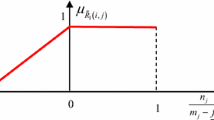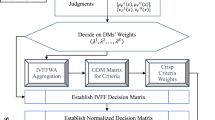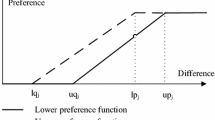Abstract
In this paper a multi-criteria group decision making model is presented in which there is a heterogeneity among the decision makers due to their different expertise and/or their different level of political control. The relative importance of the decision makers in the group is handled in a soft manner using fuzzy relations. We suppose that each decision maker has his/her preferred solution, obtained by applying any of the techniques of distance-based multi-objective programming [compromise, goal programming (GP), goal programming with fuzzy hierarchy, etc.]. These solutions are used as aspiration levels in a group GP model in which the differences between the unwanted deviations are interpreted in terms of the degree of achievement of the relative importance amongst the group members. In this way, a group GP model with fuzzy hierarchy (Group-GPFH) is constructed. The solution for this model is proposed as a collective decision. To show the applicability of our proposal, a regional forest planning problem is addressed. The objective is to determine tree species composition in order to improve the values achieved by Pan-European indicators for sustainable forest management. This problem involves stakeholders with competing interests and different preference schemes for the aforementioned indicators. The application of our proposal to this problem allows us to be able to comfortably address all these issues. The results obtained are consistent with the preferences of each stakeholder and their hierarchy within the group.



Similar content being viewed by others
Notes
\(x_{ext}\) note the extended vector of decision and auxiliary variables.
References
Aköz, O., & Petrovic, D. (2007). A fuzzy goal programming method with imprecise goal hierarchy. European Journal of Operational Research, 181, 1427–1433.
Ananda, J., & Herath, G. (2003a). Incorporating stakeholder values into regional forest planning: A value function approach. Ecological Economics, 45, 75–90.
Ananda, J., & Herath, G. (2003b). The use of Analytic Hierarchy Process to incorporate stakeholder preferences into regional forest planning. Forest Policy and Economy, 5, 13–26.
Ananda, J., & Herath, G. (2008). Multi-attribute preference modeling and regional land-use planning. Ecological Economics, 65, 325–335.
Ananda, J., & Herath, G. (2009). A critical review of multi-criteria decision making methods with special reference to forest management and planning. Ecological Economics, 68, 2535–2548.
Bard, J. F., & Sousk, S. F. (1990). A tradeoff analysis for rough terrain cargo handlers using the AHP: An example of group decision making. IEEE Transactions on Engineering Management, 37(3), 222–228.
Bertomeu, M., Diaz-Balteiro, L., & Giménez, J. C. (2009). Forest management optimization in Eucalyptus plantations: A goal programming approach. Canadian Journal of Forest Research, 39(2), 356–366.
Bose, U., Davey, A. M., & Olson, D. L. (1997). Multi-attribute utility methods in group decision making: Past applications and potential for inclusion in GDSS. OMEGA, International Journal of Management Science, 25, 691–706.
Brans, J. P., & Vincke, P. (1985). A preference ranking organization method. Management Science, 31, 647–656.
Brans, J. P., Vincke, P., & Marechal, B. (1986). How to select and how to rank projects: The PROMETHEE method. European Journal of Operational Research, 24, 228–238.
Cai, F.-L., Liao, X., & Wang, K.-L. (2012). An interactive sorting approach based on the assignment examples of multiple decision makers with different priorities. Annals of Operations Research, 197(1), 87–108.
Choi, H., Suh, E., & Suh, C. (1994). Analytic hierarchy process: It can work for group decision support systems. Computers & Industrial Engineering, 27(1–4), 167–171.
Contreras, I., & Mármol, A. M. (2007). A lexicographical compromise method for multiple criteria group decision problems with imprecise information. European Journal of Operational Research, 181(3), 1530–1539.
Deb, K., Pratap, A., Agarwal, S., & Meyarivan, T. (2002). A fast elitist multiobjective genetic algorithm: NSGA-II. IEEE Transactions on Evolutionary Computation, 6(2), 182–197.
Diaz-Balteiro, L., González-Pachón, J., & Romero, C. (2009). Forest management with multiple criteria and multiple stakeholders: An application to two public forests in Spain. Scandinavian Journal of Forest Research, 24, 87–93.
Diaz-Balteiro, L., & Romero, C. (2003). Forest management optimisation models when carbon captured is considered: A goal programming approach. Forest Ecology and Management, 174, 447–457.
Diaz-Balteiro, L., & Romero, C. (2004). Sustainability of forest management plans: A discrete goal programming approach. Journal of Environmental Management, 71, 351–359.
Diaz-Balteiro, L., & Romero, C. (2008). Making forestry decisions with multiple criteria: A review and assessment. Forest Ecology and Management, 255, 3222–3241.
Dyer, R. F., & Forman, E. H. (1992). Group decision support with the Analytic Hierarchy Process. Decision Support Systems, 8, 99–124.
Fan, Z.-P., & Liu, Y. (2010). A method for group decision-making based on multi-granularity uncertain linguistic information. Expert System with Applications, 37, 4000–4008.
Field, D. B. (1973). Goal programming for forest management. Forest Science, 19, 125–135.
Forman, E., & Peniwati, K. (1998). Aggregating individual judgements and priorities with the Analytic Hierarchy Process. European Journal of Operational Research, 108, 165–169.
Gómez, T., Hernández, M., León, M. A., & Caballero, R. (2006). A forest plannig problem solved via linear fractional goal programming model. Forest Ecology and Management, 277, 77–88.
Gómez, T., Hernández, M., Molina, J., León, M. A., Aldana, E., & Caballero, R. (2011). A multiobjective model for forest planning with adjacency constraints. Annals of Operations Research, 190(1), 75–92.
González-Pachón, J., & Rodríguez Galiano, M. I. (2003). Transitive approximation to paiwise comparison matrices by using interval goal programming. Journal of the Operational Research Society, 54(5), 532–538.
González-Pachón, J., & Romero, C. (2001). Aggregation of partial ordinal rankings: An interval goal programming approach. Computers and Operation Research, 28(8), 827–834.
González-Pachón, J., & Romero, C. (2007). Inferring consensus weights from pairwise comparison matrices without suitable properties. Annals of Operation Research, 154, 123–132.
González-Pachón, J., & Romero, C. (2011). The design of socially optimal decisions in a consensus scenario. OMEGA, International Journal of Management Science, 39(2), 179–185.
Haralambopoulos, D. A., & Polatidis, H. (2003). Renewable energy projects: Structuring a multi-criteria group decision-making framework. Renewable Energy, 28(6), 961–973.
Harrison, S. R., & Qureshi, M. E. (2000). Choice of stakeholder groups and members in multi-criteria decision models. Natural Resources Forum, 24, 11–19.
Hasle, G., Haavardtun, J., Kloster, O., & Lokketangen, A. (2000). Interactive planning for sustainable forest management. Annals of Operations Research, 95(1–4), 19–40.
Hayashi, K. (2000). Multicriteria analysis for agricultural resource management: A critical survey and future perspectives. European Journal of Operational Research, 122, 486–500.
Inventario Forestal CAE 2005 Guipuzcoa. http://www.nasdap.ejgv.euskadi.net/50-15135/es/contenidos/.
Jiménez, M., Rivas, J. A., & Puerta, C. (2012). Regional forest planning using multiobjective programming and goal programming. International Journal of Multicriteria Decision Making, 2(4), 338–354.
Jones, D. (2011). A practical weight sensitivity algorithm for goal and multiple objective programming. European Journal of Operational Research, 213, 238–245.
Jones, D. & Jiménez, M. (2013). Incorporating additional meta-objectives into the extended lexicographic goal programming framework. European Journal of Operational Research, 227, 343–349.
Jones, D. F., & Tamiz, M. (2010). Practical Goal programming. New York: Springer.
Kangas, J. (1994). An approach to public participation in strategic forest management planning. Forest Ecology and Management, 70, 75–88.
Kilgour, D. M., & Eden, C. (2010). Handbook of group decision and negotiation (advances in group decision and negotiation 4). New York: Springer.
Korpela, J., & Tuominen, M. (1995). Group decision support for defining the vision and strategic goals for distribution logistics. Proceedings of the twenty-eighth Hawaii international conference on systems sciences, (Vol. 4, pp. 475–484).
Korpela, J., & Tuominen, M. (1997). Group decision support for analysing logistics development projects. Hawaii international conference on system sciences (Vol. 2, pp. 493–502).
Lai, V. S., Bo, K. W., & Cheung, W. (2002). Group decision making in a multiple criteria environment: A case using the AHP in software selection. European Journal of Operational Research, 137, 134–144.
Leyva-López, J.-C., & Fernández-González, E. (2003). A new method for group decision support based on ELECTRE III methodology. European Journal of Operational Research, 148, 14–27.
Linares, P., & Romero, C. (2002). Aggregation of preferences in an environmental economics context: A goal programming approach. OMEGA, International Journal of Management Science, 30, 89–95.
Lu, J., Zhang, G., Ruan, D., & Wu, F. (2007). Multi-objective group decisison making: Methods, software and applications with fuzzy set techniques. Series in Electrical and Computer Engineering (Vol. 6). Imperial College Press.
Macharis, C., Brans, J. P., & Mareschal, B. (1998). The GDSS PROMETHEE procedure. Journal of Decision Systems, 7, 283–307.
Matsatsinis, N. F., & Samaras, A. P. (2001). MCDA and preference disaggregation in group decision support systems. European Journal of Operational Research, 130(2), 414–429.
Mendoza, G. A., & Martins, H. (2006). Muti-criteria decision analysis in natural resource management: A critical review of methods and new modelling paradigms. Forest Ecology and Management, 230, 1–22.
Pfeiffer, J., Golle, U., & Rothlauf, F. (2008). Reference point based multi-objective evolutionary algorithms for group decisions. Proceedings of the genetic and evolutionary computation conference (GECCO’08) (pp. 697–704). ACM Press, New York.
Romero, C. (2001). Extended lexicographic goal programming approach: An unifying approach. OMEGA, International Journal of Management Science, 29, 63–71.
Romero, C. (2004). A general structure of achievement function for a goal programming model. European Journal of Operational Research, 153, 675–686.
Romero, C., & Rehman, T. (2003). Multiple criteria analysis for agricultural decisions (2nd ed.). Amsterdam: Elsevier.
Roy, B. (1968). Classement et choix en prsence de points de vue multiple (la mthode electre). RAIRO, 2, 57–75.
Rustagi, K. P. (1973). Forest management planning for timber production: A goal programming approach. Ph.D. Thesis, Yale University, New Haven, CT.
Saaty, T. L. (1980). The analytical hierarchy process. New York: McGraw-Hill.
Saaty, T. L. (1986). Axiomatic foundations of the analytical hierarchy process. Management Science, 32, 841–855.
Sanayei, A., & Farid Mousavi, S. (2010). Group decision making process for supplier selection with VIKOR under fuzzy environment. Expert Systems with Applications, 37(1), 24–30.
Sen, N., & Nandi, M. (2012). A goal programming approach to rubber plantation planning in Tripura. Applied Mathematical Sciences, 6(124), 6171–6179.
Su, Z., Xia, G., Chen, M., & Wang, L. (2012). Induced generalized intuitionistic fuzzy OWA operator for multi-attribute group decision making. Expert System with Applications, 39, 1902–1910.
Tapia García, J. M., Moral, M. J., Martínez, M. A., & Herrera-Viedma, E. (2012). A consensus model for group decision making problems with linguistic interval fuzzy preference relations. Expert Systems with Applications, 39(11), 10022–10030.
Tavana, M., Sodenkamp, M., & Suhl, L. (2010). A soft multi-criteria decision analysis model with application to the European Union enlargement. Annals of Operation Research, 181, 393–421.
Tiwari, R. N., Dharmar, S., & Rao, J. R. (1987). Fuzzy goal programming—An additive model. Fuzzy Sets and Systems, 24, 27–34.
Wheeler, B. M., & Russell, J. R. M. (1977). Goal programming and agricultural planning. Journal of Operational Research Society, 28, 21–32.
Xu, M. S., & Chen, J. Z. (2013). A general group decision support system based on the outranking relations method. Applied Mechanics and Materials, 278–280, 1984–1988.
Acknowledgments
The authors wish to gratefully acknowledge the financial support provided by the Spanish Ministry of Education, Project ECO2011-26499.
Author information
Authors and Affiliations
Corresponding author
Appendices
Appendix 1: An extended goal programming model with fuzzy hierarchy
The corresponding specifications introduced in Table 1 lead to the following models:
-
Conventional mathematical programming (CMP):
$$\begin{aligned} \begin{array}{l} \min \;\; \alpha _1 n_1 + \beta _1 p_1 \\ \mathrm {s.t.} \\ \quad f_1 (x) + n_1 - p_1 = f_1^* \\ \quad n_1 ,p_1 \ge 0,\quad n_1 \times p_1 = 0, \\ \quad x \in X. \\ \end{array} \end{aligned}$$the objective is assumed to be minimized, then we have \(n_1=0\) and \(p_1=f_1(x)-f_1^*\). By substituting this expression in the objective function of (CMP), the conventional mathematical programming model is obtained.
-
Weighting model (WM):
$$\begin{aligned} \begin{array}{l} \min \;\; \sum \limits _{i = 1}^m {\left( -\alpha _i n_i + \alpha _i p_i \right) } \\ \mathrm {s.t.} \\ \quad f_i (x) + n_i - p_i = 0 ,\quad i = 1,\ldots ,m, \\ \quad n_i, \quad p_i \ge 0,\quad n_i \times p_i = 0,\quad i = 1, \ldots ,m, \\ \quad x \in X. \\ \end{array} \end{aligned}$$In (WM) we have \(f_i(x)=p_i-n_i\) and substituing in the objective function we obtain the usual weighted model.
-
Compromise Programming (\(L_1\) metric):
$$\begin{aligned}&\min \;\; \sum \limits _{i = 1}^m {\left( \gamma _i W_i n_i +\eta _i W_i p_i \right) } \end{aligned}$$$$\begin{aligned}&\mathrm {s.t.} \\&\quad f_i (x) + n_i - p_i = f_i^* ,\quad i = 1,\ldots ,m, \\&\quad n_i ,p_i \ge 0,\quad n_i \times p_i = 0,\quad i = 1, \ldots ,m, \\&\quad x \in X. \\ \end{aligned}$$In this case we have \(\gamma _i=0\) for minimizing objectives and \(\eta _i=0\) for maximizing objectives; \(W_i\) is a preferential as well as normalizing factor.
-
Compromise Programming (\(L_\infty \) metric):
$$\begin{aligned} \begin{array}{l} \min \;\; D \\ \mathrm {s.t.} \\ \quad \gamma _i W_i n_i +\eta _i W_i p_i \le D \\ \quad f_i (x) + n_i -p_i = f_i^* ,\quad i = 1,\ldots ,m, \\ \quad n_i ,p_i \ge 0,\quad n_i \times p_i = 0,\quad i = 1, \ldots ,m, \\ \quad x \in X. \\ \end{array} \end{aligned}$$ -
linear GP with Archimedian weights:
$$\begin{aligned} \begin{array}{l} \min \;\; \sum \limits _{i = 1}^m {\left( \alpha _i n_i + \beta _i p_i \right) } \\ \mathrm {s.t.} \\ \quad f_i (x) + n_i - p_i = t_i ,\quad i = 1,\ldots ,m, \\ \quad n_i ,p_i \ge 0,\quad n_i \times p_i = 0,\quad i = 1, \ldots ,m, \\ \quad x \in X. \\ \end{array} \end{aligned}$$ -
MINMAX GP:
$$\begin{aligned} \begin{array}{l} \min \;\; D \\ \mathrm {s.t.} \\ \quad \alpha _i n_i +\beta _i p_i \le D \\ \quad f_i (x) + n_i -p_i = t_i ,\quad i = 1,\ldots ,m, \\ \quad n_i ,p_i \ge 0,\quad n_i \times p_i = 0,\quad i = 1, \ldots ,m, \\ \quad x \in X. \\ \end{array} \end{aligned}$$ -
Extended GP:
$$\begin{aligned} \begin{array}{l} \min \;\; \left( 1-\lambda \right) D + \lambda \sum \limits _{i = 1}^m {\left( \alpha _i n_i + \beta _i p_i \right) } \\ \mathrm {s.t.} \\ \quad \alpha _i n_i +\beta _i p_i \le D \\ \quad f_i (x) + n_i -p_i = t_i ,\quad i = 1,\ldots ,m, \\ \quad n_i ,p_i \ge 0,\quad n_i \times p_i = 0,\quad i = 1, \ldots ,m, \\ \quad x \in X. \\ \end{array} \end{aligned}$$
Parameter \(\lambda \) weights the importance attached to the minimizing of the weighted sum of unwanted desviation variables. For \(\lambda \in \left( 0,1\right) \) we have intermediate solutions between the solutions provided by de MINMAX GP model \(\left( \lambda =0 \right) \) and the Archimedian GP model \(\left( \lambda =1 \right) \).
-
Archimedean GP with Fuzzy Hierarchy:
$$\begin{aligned} \begin{array}{l} \min \;\; \lambda \sum \limits _{i = 1}^m \displaystyle \gamma _{i}\frac{n_i}{u_i} + \displaystyle \eta _{i}\frac{p_i }{u_i} - \left( 1- \lambda \right) \mathop {\mathop {\mathop {\sum }\limits _{i,j = 1}}_{i \ne j}}\limits ^m \; \sum \limits _{l=1}^{3} \, b_{\tilde{R}_l \left( {i,j} \right) } \mu _{\tilde{R}_l} \left( {h_i,h_j} \right) \\ \mathrm {s.t.} \\ \\ f_i (x) + n_i^{} - p_i^{} = t_i ,\quad i = 1,\ldots ,m, \\ \\ \displaystyle 1 - \left( \frac{h_i }{u_i } - \frac{h_j}{u_j } \right) \ge \mu _{\tilde{R}_1} (h_i,h_j), \quad \mathrm{{if}} \quad {b_{\tilde{R}_1 \left( i,j \right) }} = 1, \\ \\ \displaystyle \frac{1 - \displaystyle \left( \frac{h_i }{u_i } - \frac{h_j}{u_j } \right) }{2} \ge \mu _{\tilde{R}_2} (h_i,h_j),\quad \mathrm{{if }} \quad b_{\tilde{R}_2} \left( i,j \right) = 1, \\ \\ \displaystyle \frac{{h_j }}{{u_j }} - \frac{{h_i} }{{u_i }} \ge \mu _{\tilde{R}_3} (h_i,h_j),\quad \mathrm{{if }} \quad {b_{\tilde{R}_3 \left( {i,j} \right) }} = 1, \\ \quad i,j = 1, \ldots , m, \\ \\ \quad 0 \le \mu _{\tilde{R}_l} (h_i,h_j) \le 1,\quad l = 1,2,3, \\ \\ \quad n_i ,p_i \ge 0,\quad n_i \times p_i = 0,\quad i = 1, \ldots ,m, \\ \\ \quad x \in X. \\ \end{array} \end{aligned}$$ -
MINMAX GP with Fuzzy Hierarchy:
$$\begin{aligned}&\min \;\;\lambda D - \; \left( 1- \lambda \right) \mathop {\mathop {\mathop {\sum }\limits _{i,j = 1}}_{i \ne j}}\limits ^m \; \sum \limits _{l=1}^{3} \, b_{\tilde{R}_l \left( {i,j} \right) } \mu _{\tilde{R}_l} \left( {h_i,h_j} \right) \\&\mathrm {s.t.} \\&\displaystyle \gamma _{i}\frac{n_i}{u_i} + \displaystyle \eta _{i}\frac{p_i}{u_i} \le D \\&f_i (x) + n_i^{} - p_i^{} = t_i ,\quad i = 1,\ldots ,m, \\&\displaystyle 1 - \left( \frac{h_i }{u_i } - \frac{h_j}{u_j }\right) \ge \mu _{\tilde{R}_1} (h_i,h_j),\quad \mathrm{{if}} \quad {b_{\tilde{R}_1 \left( i,j \right) }} = 1, \\&\displaystyle \frac{1 - \displaystyle \left( \frac{h_i }{u_i } - \frac{h_j}{u_j } \right) }{2} \ge \mu _{\tilde{R}_2} (h_i,h_j),\quad \mathrm{{if }} \quad b_{\tilde{R}_2} \left( i,j \right) = 1, \\&\displaystyle \frac{{h_j }}{{u_j }} - \frac{{h_i} }{{u_i }} \ge \mu _{\tilde{R}_3} (h_i,h_j) ,\quad \mathrm{{if }} \quad {b_{\tilde{R}_3 \left( {i,j} \right) }} = 1, \\&\quad i,j = 1, \ldots , m, \\&\quad 0 \le \mu _{\tilde{R}_l} (h_i,h_j) \le 1,\quad l = 1,2,3, \\&\quad n_i ,p_i \ge 0,\quad n_i \times p_i = 0,\quad i = 1, \ldots ,m, \\&\quad x \in X. \\ \end{aligned}$$
Appendix 2
Rights and permissions
About this article
Cite this article
Bilbao-Terol, A., Jiménez, M. & Arenas-Parra, M. A group decision making model based on goal programming with fuzzy hierarchy: an application to regional forest planning. Ann Oper Res 245, 137–162 (2016). https://doi.org/10.1007/s10479-014-1633-3
Published:
Issue Date:
DOI: https://doi.org/10.1007/s10479-014-1633-3




